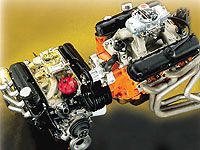
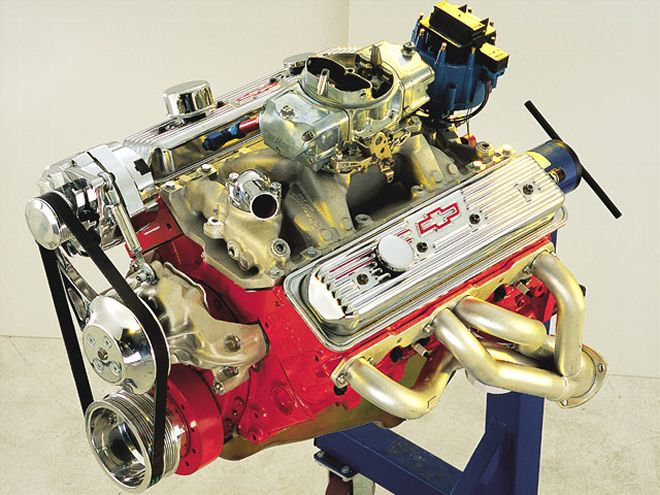
Car crafters love competition, and there's nothing like a good shootout to dump fuel on the Chevy versus Ford versus Mopar fire. So it is with the Battle of the Titans comparison of three street-ready small-blocks. The plan was to see which engine could generate the best overall power curve. By now you should be familiar with the rules, but if not, the Cliff's Notes are that the engines couldn't be bigger than 365 ci, they had to run on pump gas, and they had to stick to a budget of $2,500. This was difficult for the Ford and Mopar guys, mainly because these engines cost more to build than a small-block Chevy. But that's the reality of the performance world.
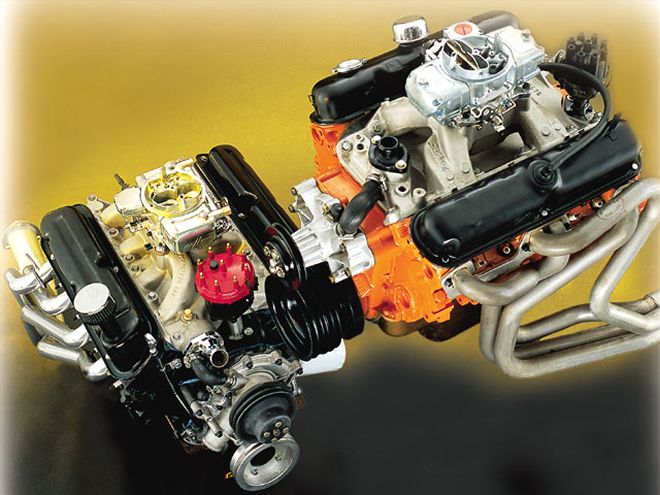
The first man up to the plate was CC's Mopar man Marko Radielovic, who laid down the gauntlet by choosing a "damn the idle vacuum--full speed ahead" Crane cam measuring 242/252 degrees at 0.050-inch tappet lift with a 108 degree lobe separation angle. That friends, falls relatively far from the daily-driver category, but since there were no rules concerning idle vacuum, Marko went for the jugular.
Henry De Los Santos, our resident Ford guy, built a very similar 351W-based small-block using GT-40P iron heads. He splurged on a set of 1.7:1 Crane roller rockers, but when it came time for the cam, Henry chose a more conservative route with a Crane Power Max hydraulic flat-tappet stick with 234/238 degrees at 0.050-inch tappet lift with a similar lobe separation angle of 108 degrees. While the 8-degree-shorter duration at 0.050 on the intake doesn't sound like much, it proved to be the smallest of the three cams and may have hurt the Ford's chances for a stronger finish.
Terry McGean got the nod to construct the Bow Tie engine, and he followed the now-familiar path for the short-block with production-based components and a set of Vortec heads modified by Scoggin-Dickey to accommodate the additional lift of a big Crane PowerMax hydraulic flat-tappet cam. McGean also pumped up the cam with a similar grind to the Mopar with a 244/252 degrees at 0.050-inch tappet lift selection and an even tighter 106-degree lobe separation angle.
All three engines used Edelbrock Performer RPM dual-plane intakes, a Barry Grant Demon 750-cfm carburetor, and similar Hooker chassis headers. All three engines were machined, assembled, and tested at JMS Racing Engines so we didn't have to worry about variations between different dynos.
The classic line is that the combination is what determines the power curve, so we decided to look a little closer at the camshaft numbers relative to the cylinder-head flow data. We couldn't find flow data on the Mopar head, but some info on the GT-40P head indicates that the exhaust side is a little weak (typical of many production Ford small-block heads) and probably could have used a greater exhaust duration to help evacuate the cylinders, especially at higher rpm levels.
Conversely, the Chevy Vortec heads, offer a slightly better exhaust port but really benefit from excellent intake flow numbers in the 0.300- and 0.400-inch valve-lift areas. While max cam lift for the Chevy was more than 0.525 inch, it is the cylinder head's flow potential at the mid-valve lifts that generally contribute to a strong power curve throughout the entire rpm band. This is the case with the Vortec heads. In fact, comparisons of the Vortec heads to the top-10 aftermarket aluminum small-block heads consistently places the Vortec head in the top five category in these mid-lift flow areas. This cannot be emphasized enough, and no doubt it was the cylinder heads that contributed more to the Chevy's success than any other single component.
Numbers Don't Lie
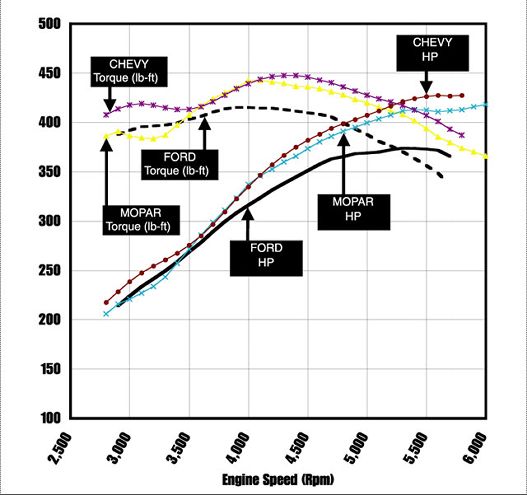
The goal of this test was really twofold. The first was overall power, and the second was peak power. Often you'll find an engine that makes great peak power but is a little weak when it comes to the midrange torque curve. However, in this case the Chevy not only won the peak power contest but also made more overall power than the other engines. The Mopar did make a little more torque between 3,500 and 4,000, but that was the only place where the Bow Tie engine was challenged. As you can see from the charts, the small-block Mopar put up a great effort with peak numbers very similar to the Chevy's, but closer inspection of average torque reveals the Chevy made more than 14 lb-ft more torque than the Mopar and 30 lb-ft more average torque than the Ford engine. Unfortunately, the Ford was down compared to the other two engines, coming in over 50hp shy of the Chevy and the Mopar and around 30-lb-ft short on the torque side.
Take a Dip
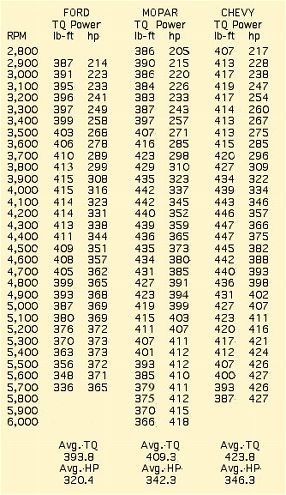
If you look at the graph of all three engines, you can see an interesting dip in the torque curve for both the Mopar and the Chevy. The Mopar hits the dip first between 3,000 and 3,300, while the Chevy sags between 3,500 and 4,000. These troughs in the power curve are common in engines with large amounts of camshaft overlap. As mentioned earlier, both the Mopar and Chevy engines used larger-duration cams with tight lobe separation angles that increase the amount of overlap (when both the intake and exhaust valves are open). This can cause higher pressures in the intake manifold that can reduce the signal to the carburetor and cut fuel flow. Increasing the fuel flow in this rpm area only often returns that lost power. This fuel-flow increase can be worth from 10 to 15 lb-ft of torque. This is of importance if you happen to be using a torque converter with a stall speed of 3,000 rpm, for example, as in the Mopar's case. With torque multiplication ratios in a converter of over 2:1, a loss of 25 lb-ft here is the equivalent of losing 50 lb-ft to the input shaft of the transmission.
Conclusions
We can be assured of at least two things that will result from our first shot at Battle of the Titans. The first is that no self-respecting Ford guy is going to jump ship and build a Chevy just because the Ford engine didn't do well in our test. Does that mean all small-block Ford 351W engines are lame? Hardly. The second obvious result is that this Titans shootout will only feed the controversy over which engines are better. We don't claim to have any better handle on the crystal-ball routine than those phony Coney Island madams, and it looks like the Battle of the Titans has created as many questions as it answered. And if there are enough of you out there who'd like to see a pocket-porting rematch, we could be coerced into another round. Tell us what you think. Just keep the verbal abuse to a minimum.
Wheel to Wheel
Since the only people who race dynos are magazine writers, we decided to plug all three power curves into the Racing Systems Analysis (RSA) Quarter Pro dragstrip simulation program. We have over a dozen years of experience using this program to evaluate quarter-mile potential with various power combinations.
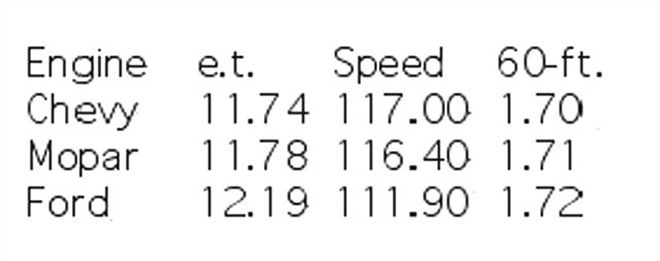
The beauty of a computer simulation is that we can "bolt" all three engines into the same theoretical car. We chose a car that shifted at 6,500 rpm and spec'd out at 3,400 pounds using a 2,500-stall converter with 5 percent slippage, a three-speed automatic trans turning a 3.73 rear gear, and 26-inch-tall sticky rear tires. To no one's surprise, the simulations followed the power curves, but the interesting thing was the subtle performance difference between the Chevy and the Mopar. Despite the Chevy's obvious power advantage, the simulation showed a quarter-mile e.t. difference of only 0.03 second and 0.60 mph (11.74/117 for the Chevy and 11.78/116.4 for the Mopar). The e.t. difference could easily be the differential in reaction time, making it a true heads-up contest. The Ford cranked out a respectable 12.19/111.9 mph pass. All runs were simulated at sea level on a 72 degree F day with a barometer of 29.92.
With a Little Help From Our Friends
A project like this is not only very time-consuming but also downright expensive. First of all, we'd like to acknowledge JMS Racing Engines for the time, consideration, and effort that went into a battle of this scope.
Of equal importance are the several layers of help that came directly from Crane Cams and the crew from Daytona Beach, Florida. Several other companies also contributed to this exercise and we also want to note their involvement.